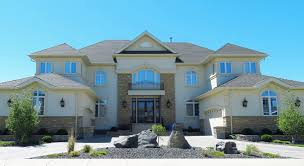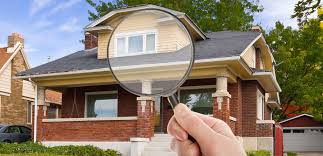“Mold Removal” vs. Mold Remediation
What’s the Difference?
If a company is promising to remove the mold from your home, you may want to double check that company’s credentials. Mold spores are floating in the air and on every surface, both indoors and outdoors. Something as small, naturally occurring and found everywhere as mold would be hard to completely and totally remove all mold from your home. While the thought of mold being around you right now can be overwhelming, mold remediation is very possible. The remediation process contains the mold damage in your home, mitigating any additional damage or issues
Understanding Mold
When water intrudes into your property, mold growth can start in as little as 48 hours. Consider the following mold facts:
Mold is present almost everywhere, indoors and outdoors.
Mold spores are microscopic, float along in the air, and may enter your home through windows, doors, or AC/heating systems or even hitch a ride indoors on your clothing or a pet.
Mold spores thrive on moisture. Mold spores can quickly grow into colonies when exposed to water. These colonies may produce allergens and irritants.
Before mold remediation can begin, any sources of water or moisture must be addressed. Otherwise, the mold may return.
Mold often produces a strong, musty odor, and that odor can lead you to possible mold problem areas.
Even higher-than-normal indoor humidity can support mold growth. Keep indoor humidity below 45 percent.
The Mold Remediation Process
Every mold damage scenario is different and requires a unique solution, but the general mold remediation process stays the same.
Inspection and Mold Damage Assessment
Mold Containment
Air Filtration
Removing Mold and Mold-Infested Materials
Cleaning Contents and Belongings

Mold
Mold spores need water to grow. In most instances, mold problems occur when there is excess water. Mold problems in a bathroom resulting from steam can be controlled by wiping down shower walls and using an exhaust fan when showering.
When a mold problem exists which can’t be readily traced to a leak, it is recommended that the building be inspected in order to identify the excess water source. Once the problem has been identified and corrected, proper mold remediation can be performed.
Health Effects of Mold
Mold can be a health concern. Unfortunately, it is not known how much mold is needed to cause health problems. However, there are factors that can be used to assess whether an increased health risk may be present. These include evaluating the individual who has been exposed and the extent and conditions of the mold growth. Some individuals who have pre‐existing health conditions may be at an increased risk. Individuals who have allergies or lung conditions such as asthma or emphysema can exhibit health effects from exposure. Very young infants and the elderly may also be at an increased risk of health issues relating to mold exposure.
Information for Renters
Renters who have mold problems in their rental space often have difficulty getting the mold problem corrected. Due to the lack of regulations, government offices have little authority to cite building owners regarding mold contamination. Renters should contact their local building code office regarding any unrepaired building leaks. When doing so, please be reminded that building code offices, like other government offices, most likely do not have mold regulations. Therefore, they will only be able to address structural deficiencies such as water leaks, plumbing issues, etc. You may also want to consider seeking legal advice regarding your rights in this situation.
Mold Inspections, Testing, Remediation and Training
Environmental Consultants
A list of Environmental Consultants who provide mold and other indoor air and environmental health services in residential dwellings. These companies may also perform additional environmental health testing and investigative services for contaminants such as asbestos containing materials, lead-based paint and radon.
Laboratories
A list of laboratories who have expertise in microbiology for mold and bacterial analysis. These laboratories may also provide analytical services for other indoor environmental contaminants.
Remediation Firms
A list of remediation firms who perform mold remediation and clean-up services.
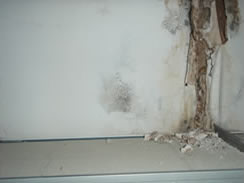
Mold Remediation
For spaces found to be “moldy” (i.e., water-damaged, regardless of the findings on testing, when used), remediation by certified personnel is recommended. Improper efforts can spread microbes (such as mold, bacteria and parasites), spores, fragments and toxins throughout the entire structure as water-damaged building materials are removed. As such, in many cases, occupants should be relocated during the remediation process.
Because many factors must be considered when remediating water-damaged homes, schools, offices and other buildings, and because there are several industry guidelines and government publications about remediation, it is not practical to provide a detailed discussion of mold remediation in this paper. However, we will be discussing a few key topics relating to remediation.
It is important to state there are some water damage situations that cannot be resolved or corrected with remediation, and remediation is not always successful. If remediation is attempted, proper containment procedures and personal protective equipment are critical, because disturbing or handling the contaminants can result in increased aerosolized spores and particles containing mycotoxins which can be dangerous to human health and destructive to property.
Personal Protective Equipment (PPE)
During remediation or renovation of water-damaged structures, personal protective equipment (PPE) should be used to protect the occupants and workers.
Protective clothing that covers the entire body (i.e., a disposable body suit such as TYVEK with mold-impervious, disposable head and foot coverings). All gaps in the clothing, such as those around ankles and wrists, should be sealed.
An N-95 respirator or better (i.e., a half-face or full-face respirator with N, R or P100 filters).
Protective gloves (made of natural rubber, neoprene, nitrile, polyurethane or polyvinylchloride). Do not touch mold or moldy items with bare hands.
Non-vented goggles. Wear goggles that provide complete eye protection. Choose goggles designed to keep out dust and small particles. Safety glasses or goggles that have open vent holes will not protect you against dust and small particles.
HVAC Systems and Ducts
HVAC (heating, ventilating, and air-conditioning) systems and ducts are common topics in regard to remediation of homes and buildings with mold contamination. As mentioned above, there are some situations that cannot be remediated. HVAC systems are difficult because there are many parts and because it is used to move air through the structure.
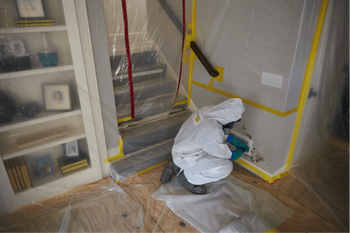
What to Expect from Mold Remediation on a House
What Is Mold Remediation?
Mold remediation is typically the removal, cleaning, and disinfecting of mold-contaminated areas such as inside a home. Remediation process entails the use of specialized equipment and methods to ensure complete removal while preventing new growth of mold.
What Can You Expect During Mold Remediation?
While every mold damage situation varies and demands a unique solution, the mold remediation process remains the same.
Repair of the water plumbing system. This will help prevent the growth of new mold spores.
Isolation of mold containment area. This entails sealing off the contaminated area from the other parts of the house. This is done by closing all windows and doors. Other openings are sealed using six mil polyethylene sheeting. The sheeting seams are then sealed using duct tapes.
Control airborne spores. This is done by misting the contaminated spots.
Vacuuming of moldy surfaces. While vacuuming, the wet/dry vacuum is kept outside.
Cleaning and Removal of moldy materials. All wet and mold-contaminated material is discarded in plastic bags to lower the risk of mold spores getting dispersed into the air. Proper cleaning of all non-porous materials is done.
Spraying and scrubbing of unmovable structure elements. The professionals will then scrub all mold-contaminated surfaces with a damp cloth soaked in a detergent solution. This will help ensure all mold is completely removed.
Disinfecting and encapsulating surfaces. The cleaned areas are then disinfected using the appropriate products and deodorizing agents to remove and kill any mold left.
Drying wet materials. All the cleaned materials are then allowed to dry to ensure no moisture is leftover. Some expert mold removal companies will speed up the process using dehumidifiers, fans, or by increasing the indoor air temperature.
Replace and rebuild. All damaged materials previously removed are then repaired or replaced.
How Long Will It Take?
How long it will take to perform the entire mold remediation process varies depending on various factors. Some of them include the amount of mold present, the part of the house mold is growing, and the type of material with mold-contamination. However, the process can take between one to five days.
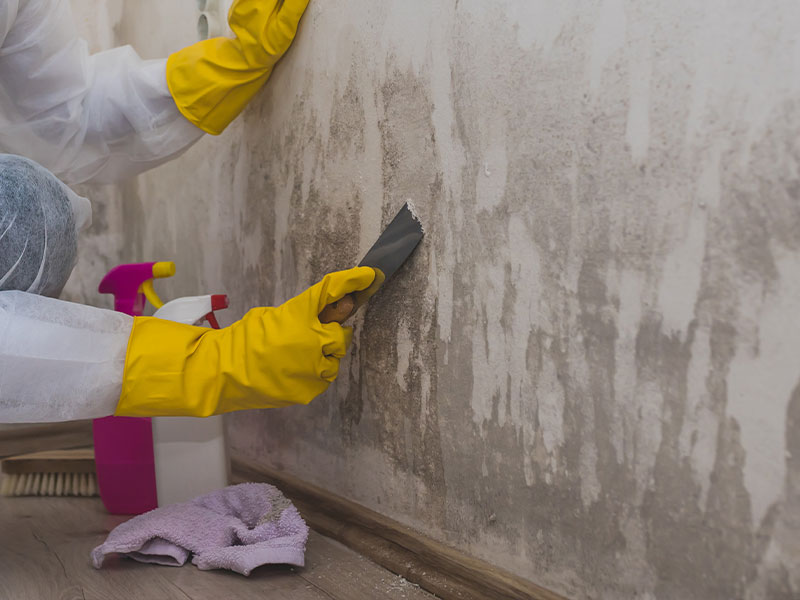
Mold Remediation Services You Can Count On
No facilities manager wants to hear that a building has mold, especially not if a lot of people spend time in the building. Left unchecked, mold growth can spread throughout a building’s insulation, ceilings, walls, carpeting, and HVAC system. High mold spore counts can cause respiratory problems and allergic reactions. Sick employees, guests, or students are a lawsuit waiting to happen. If you or a resident discovers moldy areas in one or more of your buildings, don’t delay.
WHAT IS MOLD REMEDIATION?
Mold remediation focuses on getting your building’s mold problem under control. There will always be a certain amount of naturally occurring mold spores in the air, but when humid conditions, an undetected roof leak, a plumbing leak, flooding, or other moisture problem causes mold to grow, you need to call trusted mold remediation specialists. In many commercial facilities, the existence of a mold issue isn’t revealed until other renovations or repairs are underway.
INSPECTION AND MOLD DAMAGE ASSESSMENT
When we come to your location, we will do a visual inspection for mold. We may ask for the results of any air quality tests you have had done. We may cut into drywall, lift up carpeting, etc., to determine the extent of the spread of the mold. We may also use a moisture meter to determine how much moisture is in the air.
IDENTIFYING THE ROOT CAUSE OF THE MOLD
Mold only grows in areas where it is damp or moist. We will identify the root cause of the moisture, and come up with a targeted solution. Causes of moisture in a building can include:
Leaking pipes
An HVAC system that is not removing enough humidity
Foundation moisture issues
Faulty construction
A one-time event, such as flooding
MOLD CONTAINMENT
Proper mold containment will keep the mold spores in the affected area from spreading during the mold remediation process. We’ll install a HEPA Filtered Negative Air machine, which will pull contaminated air out, and exhaust it outside through flexible tubing. Your HVAC system will be turned off during the mold remediation process to prevent mold spores from circulating to uncontaminated areas. .

